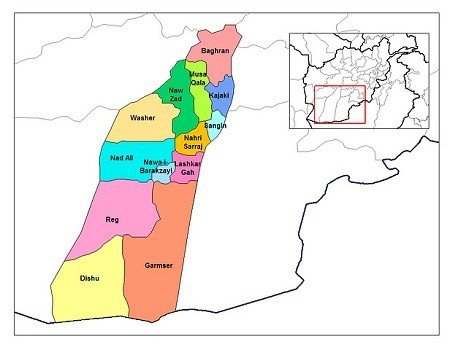
Afghanistan’s largest province, located in the southwest of the landlocked country, is the objective of a resurgent Taliban offensive. According to some news reports the Taliban control 11 of the 14 districts in Helmand province. Almost all roads connecting the provincial capital of Lashkar Gah to other areas of Afghanistan are controlled by the Taliban.
What is District Control?
The assessing of who controls what district is murky at best. It all depends on who is doing the assessing, of course. If you listen to the Afghan government you would be led to believe that the Taliban control only six districts throughout the entire country. The Resolute Support Headquarters spokesmen have a slightly less optimistic – but still very unrealistic way of counting.
If the district center – a small compound of 3-6 buildings that houses the district governor, district police center, and a few other governmental offices – is held by the government (20-30 Afghan National Police and perhaps an infantry platoon or company) – then the district is under government control. The fact that the insurgents control all the land mass of the district beyond the maximum effective range of the government security forces small arms is beside the point. The district is labeled ‘under government control’. Food for thought.
Helmand Provincial Capital Threatened
Lashkar Gar is experiencing food, fuel, water and medical shortages. There are thousands of refugees cramming the city seeking shelter from the fighting in the countryside. Morale among the Afghan National Defense Security Forces (ANDSF) is extremely low. The Taliban gain significant financial benefit in controlling the province as the opium trade provides funding for its operations.
Helmand province has been the scene of intense fighting over the years – especially since 2006. Many Coalition countries have deployed their troops to this troubled province. These countries include the United States (primarily the U.S. Marines), the British, and the Danes.
One factor in the favor of the ANDSF is the willingness of the Coalition to employ airstrikes to blunt significant gains by the Taliban. The rules of engagement (RoE) recently were loosened allowing more intervention by U.S. air assets. If Lashkar Gar were to fall to the Taliban it would be the second provincial capital to be captured in one year. In late 2015 Kunduz City (of Kunduz province) was captured by the Taliban and held for several days.
Read more on this topic in “The Battle for Helmand: Afghanistan’s Largest Province May Fall Entirely to the Taliban”, by Ankit Panda, The Diplomat, August 11, 2016.